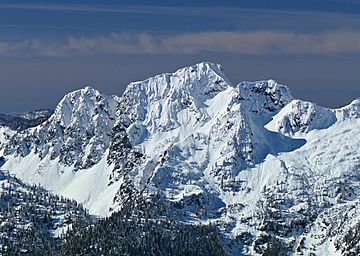Logger Butte facts for kids
Quick facts for kids Logger Butte |
|
|---|---|

Logger Butte seen from Oakes Peak
|
|
| Highest point | |
| Elevation | 6,160+ ft (1,880+ m) |
| Prominence | 720 ft (220 m) |
| Geography | |
| Parent range | North Cascades Cascade Range |
| Topo map | USGS Damnation Peak |

Logger Butte is a mountain peak in Washington state. It stands about 6,160 feet (1,878 meters) tall. You can find it near the western edge of the North Cascades mountains.
Logger Butte is located in Skagit County. It sits north of Marblemount and Diobsud Buttes. The mountain is right on the border of North Cascades National Park and the Noisy-Diobsud Wilderness. The closest taller mountain is Electric Butte, which is about 1 mile (1.6 km) to the north. Rain and melted snow from Logger Butte flow into streams that eventually join the Skagit River.
Weather at Logger Butte
Logger Butte is in a "marine west coast" climate zone. This means its weather is strongly affected by the nearby Pacific Ocean. Most weather systems come from the Pacific Ocean. They travel northeast towards the Cascade Mountains.
When these weather systems hit the North Cascades, the mountains force the air upward. This causes the air to cool and drop its moisture. This moisture falls as rain or snow on the mountains. This process is called Orographic lift. Because of this, the western side of the North Cascades gets a lot of rain and snow, especially in winter.
The climate here is mild because it's close to the ocean. Temperatures rarely go below 0°F (-18°C) or above 80°F (27°C). In winter, it's often cloudy. But in summer, high-pressure systems over the Pacific Ocean bring clear skies. The snow tends to be wet and heavy due to the ocean's influence. This can lead to a high risk of avalanches.
How Logger Butte Was Formed
The North Cascades mountains have very rugged land. You can see sharp peaks, long ridges, and deep valleys carved by glaciers. These amazing shapes were created by geological events millions of years ago. These events also caused big changes in elevation, which led to different climates and types of plants in the area.
The Cascade Mountains started forming millions of years ago, during the late Eocene Epoch. This happened because the North American Plate was slowly moving over the Pacific Plate. This movement caused many volcanic eruptions. Also, small pieces of the Earth's crust, called terranes, came together. This helped create the North Cascades about 50 million years ago.
Over two million years ago, during the Pleistocene period, glaciers grew and then melted many times. As they moved, these huge ice sheets scraped the land. They left behind piles of rock and debris. The "U"-shaped valleys you see today were carved out by these glaciers. The main forces that created the tall peaks and deep valleys of the North Cascades are uplift (when land is pushed up) and faulting (when the Earth's crust breaks), combined with the action of glaciers.



